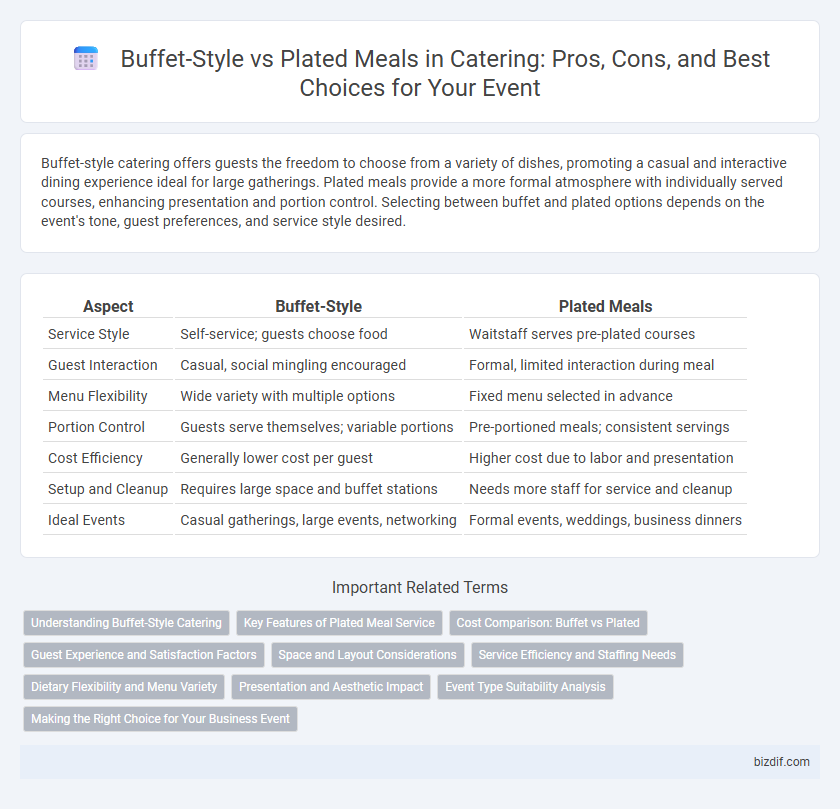Buffet-style catering offers guests the freedom to choose from a variety of dishes, promoting a casual and interactive dining experience ideal for large gatherings. Plated meals provide a more formal atmosphere with individually served courses, enhancing presentation and portion control. Selecting between buffet and plated options depends on the event's tone, guest preferences, and service style desired.
Table of Comparison
| Aspect | Buffet-Style | Plated Meals |
|---|---|---|
| Service Style | Self-service; guests choose food | Waitstaff serves pre-plated courses |
| Guest Interaction | Casual, social mingling encouraged | Formal, limited interaction during meal |
| Menu Flexibility | Wide variety with multiple options | Fixed menu selected in advance |
| Portion Control | Guests serve themselves; variable portions | Pre-portioned meals; consistent servings |
| Cost Efficiency | Generally lower cost per guest | Higher cost due to labor and presentation |
| Setup and Cleanup | Requires large space and buffet stations | Needs more staff for service and cleanup |
| Ideal Events | Casual gatherings, large events, networking | Formal events, weddings, business dinners |
Understanding Buffet-Style Catering
Buffet-style catering offers guests a diverse selection of dishes presented in an open layout, allowing personalized portion sizes and multiple servings. This approach enhances guest interaction and accommodates dietary preferences more effectively compared to plated meals, which feature pre-portioned courses served individually. Catering professionals often recommend buffets for large events and casual settings due to greater flexibility and efficiency in service.
Key Features of Plated Meal Service
Plated meal service offers guests individually portioned dishes presented with precision, enhancing the dining experience through refined presentation and controlled portions. This style allows for easier dietary accommodations and maintains food quality by serving fresh, hot meals directly to each guest. The formal nature of plated meals supports upscale events and ensures efficient service by staff trained in synchronized dish delivery.
Cost Comparison: Buffet vs Plated
Buffet-style catering typically reduces labor costs due to fewer servers required, making it more cost-effective for large groups, while plated meals incur higher expenses from additional staff and service time. Food waste is often higher with buffets because of over-preparation, potentially increasing overall costs, whereas plated meals allow for precise portion control and reduced waste. Event size and menu complexity also influence costs, with buffets being more economical for casual gatherings and plated meals favoring formal events despite their higher price point.
Guest Experience and Satisfaction Factors
Buffet-style catering offers guests variety and control over portion sizes, enhancing satisfaction through personalized meal choices and social interaction opportunities. Plated meals provide a more formal dining experience with consistent portion control and presentation, often elevating guest perception of quality and service. Factors influencing guest experience include dietary preferences, event type, and atmosphere, making the choice between buffet and plated meals crucial for maximizing overall satisfaction.
Space and Layout Considerations
Buffet-style catering requires ample space to accommodate multiple food stations and allows guests to move freely, making it ideal for large, open venues. Plated meals need a more structured layout with sufficient room for servers to navigate between tables efficiently, which suits smaller or formal settings. Considering the venue's floor plan and guest flow is crucial to optimize comfort and service speed for either meal style.
Service Efficiency and Staffing Needs
Buffet-style catering enhances service efficiency by allowing guests to serve themselves, reducing the need for extensive staffing and expediting meal distribution. Plated meals require a higher number of servers to individually deliver and clear dishes, increasing labor costs and staffing complexities. Choosing buffet-style service optimizes staffing allocation while maintaining a steady flow of food service at events.
Dietary Flexibility and Menu Variety
Buffet-style meals offer greater dietary flexibility, allowing guests to choose from a diverse selection of dishes tailored to various dietary restrictions such as gluten-free, vegetarian, and vegan options. Plated meals provide a controlled menu with limited variety, often requiring advance notice to accommodate special dietary needs. Catering companies specializing in buffet service can efficiently cater to large groups with varied preferences, enhancing guest satisfaction through customizable options.
Presentation and Aesthetic Impact
Buffet-style catering offers a visually dynamic presentation with an array of colorful dishes arranged for guests to serve themselves, creating an interactive and vibrant dining experience. Plated meals provide a refined and elegant aesthetic, with meticulously crafted portions that emphasize precision and artistic plating on each individual plate. The choice between buffet and plated meals significantly impacts the event's atmosphere, balancing casual accessibility with formal sophistication.
Event Type Suitability Analysis
Buffet-style meals excel at accommodating large, casual events where guests prefer variety and social interaction, such as corporate mixers and weddings. Plated meals are ideal for formal occasions like gala dinners and award ceremonies, providing structured service and portion control. Selecting between the two depends on guest count, event formality, and desired dining experience to ensure optimal satisfaction.
Making the Right Choice for Your Business Event
Choosing between buffet-style and plated meals depends on the event size, budget, and desired guest experience. Buffet-style offers variety and encourages mingling, ideal for large, informal gatherings, while plated meals provide a controlled portion and refined presentation, perfect for formal corporate dinners. Evaluating attendee preferences and event logistics ensures the catering aligns with business objectives and enhances overall satisfaction.
Buffet-style vs Plated meals Infographic

 bizdif.com
bizdif.com